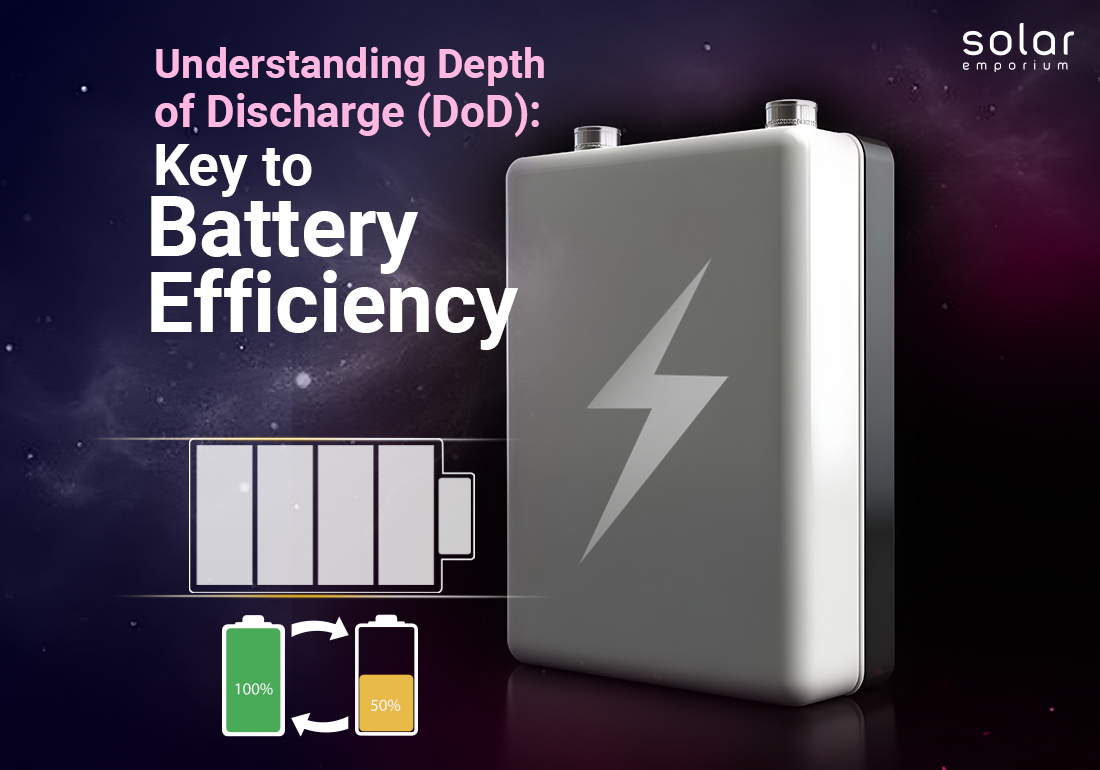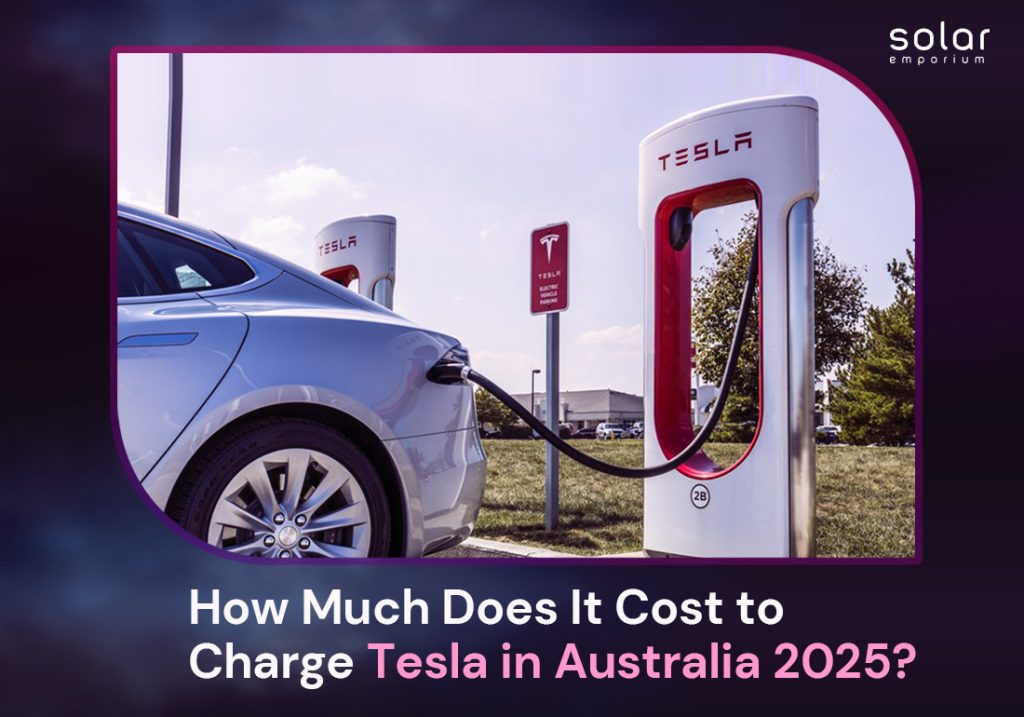As renewable energy technology advances rapidly, the need for energy storage has become more important than ever. Whether it’s your phone, electric vehicle, or solar system, every charge and discharge is crucial to a battery’s longevity and performance.
But have you ever been in a situation where your phone dies just when you need it most, or your electric vehicle’s range falls short on that important trip?
We know it’s frustrating and often unpredictable. But that’s exactly where a battery’s efficiency comes in with an often-overlooked hidden force: Depth of Discharge (DoD).
It’s a delicate balance that could make or break your device’s reliability where too deep discharges shorten your battery’s lifespan or too shallow discharge rate leaves the energy on the table.
Want to strike the right balance and utilize every drop of power in your battery while making it last longer?
Let’s dive into this blog and learn why understanding the battery’s DoD is the first step to mastering your energy game in Australia!
Depth of Discharge (DoD): The Secret to Long-Lasting Batteries in Australia
While purchasing batteries, many people often ask: what is the depth of discharge?
So, in simple terms, DoD tells us the percentage of batteries that can be used safely without degrading their lifespan. It works like a fuel gauge that indicates the amount of energy drained before charging it again.
A battery with a higher DoD allows you to utilize more of the overall storage capacity. Therefore when a battery reaches full charge, its DoD is 0%, and when half of its capacity is used, its depth of discharge rate is 50%, leaving 50% charge remaining.
So, the more a battery is discharged, the more stress it undergoes, shortening its lifespan.
On the flip side, batteries kept within a certain DoD range between 20% and 80% can last longer and maintain a higher level of efficiency.
The Role of DoD in Battery Life & Efficiency in Australia!
While batteries power everything, they truly are the lifeline that keeps our devices running and our lives connected.
Battery technology has come a long way, but one of the most significant challenges in optimizing energy storage is balancing discharge cycles without damaging the battery.
For example, many lithium-ion batteries have a recommended DoD of around 80%, which means by discharging the battery to 80% of its full capacity, you can create an ideal balance between usable energy, battery efficiency and its lifespan.
However, discharging this battery to 95% or more might lead to quicker degradation of the battery’s internal components, hampering their performance during power supply.
The True Cost of Battery Efficiency in Australia: Are You Overpaying?
As of early 2025, Australia continues to lead in the adoption of solar energy and electric vehicles (EVs).
The data shows that in January 2025, approximately 234 MW of new rooftop solar capacity was installed across the country, marking a 6% increase compared to last year.
Australia is already a leader in the adoption of solar energy and electric vehicles. In addition to 4 million installations of residential rooftop solar power systems, sales in the electric vehicle sector have also increased dramatically in the past few years.
However, are you still tired of unnecessary battery expenses? Don’t stress out!
As more Aussie households and businesses integrate solar battery storage systems, learning about depth of discharge ensures the cost-effectiveness of batteries.
By optimizing the DoD, you’re getting the most out of your battery without overusing it. In the long run, this helps reduce the need for expensive battery replacements that range from $5,000 to $15,000.
Hence, with a good understanding of DoD and regular battery maintenance, it’s high time Australian households maximized their battery performance and minimized unnecessary expenses.
How to Find the Ideal Depth of Discharge (DoD) for Your Battery Type?
Have you ever wondered what’s the optimal range for depth of discharge? How to crack the perfect balance of DoD according to your battery chemistry?
When evaluating batteries, it’s crucial to consider usable capacity or depth of discharge alongside battery longevity. These metrics are interconnected, and focusing on just one is not enough.
For example, a modern 10kWh battery with lithium-ion technology has a 100% DoD, so the question is: can we fully discharge a lithium-ion battery?
Even if you can do that, it’s not a wise choice, and you should avoid it. Why?
A fully discharged lithium-ion battery can cause the individual cells to discharge, permanently damaging the battery.
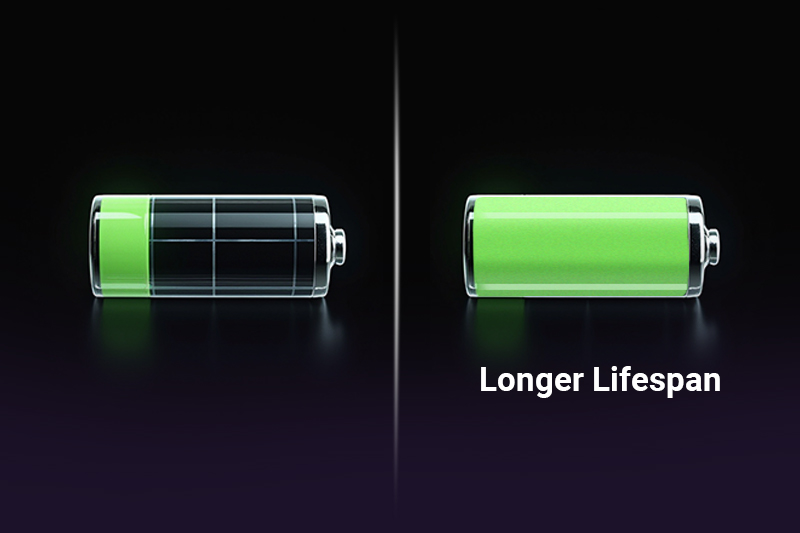
Guide to Determining the Right Depth of Discharge (DoD) for Battery
Typical home battery DoDs range from 80% to 100%, with lithium-ion and lithium iron phosphate (LiFePO4) batteries leading the way at 95 to 100%.
Many Australian battery manufacturers advertise a 100% DoD rating for their batteries. Therefore, a 10kW lithium-ion battery rated for 100% DoD could theoretically give you a maximum of 10kWh of usable power.
However, if you follow the recommendation to keep optimal DoD and discharge only 80%, you’ll use 8kWh of power for each cycle.
Remember! Without using the full capacity, these solar batteries will last longer, typically going through more charge cycles before the capacity degrades significantly.
So, here’s how the Depth of Discharge for a battery is calculated:
Depth of Discharge = [1- (Remaining Battery Capacity/Total Battery Capacity)] * 100
Let’s have a broader picture by setting an example,
Suppose your battery has a total capacity of 100 Ah (amp-hours) and currently has 70 Ah remaining power.
Depth of Discharge (DoD) = [1- (70/100)] * 100
So, the Depth of Discharge here is 30%, meaning 30% of the battery storage capacity has been used while 70% remains for later usage.
Now let’s have a closer look at how the DoD affects various types of batteries:
Depth of Discharge of Lithium-Ion Batteries (Li-ion)
Lithium-ion batteries are the most commonly used battery types in both home energy storage systems and electric vehicles across the Australian states.
They are popular because of their high energy density, efficiency, and relatively long lifespan. These batteries generally have an incredible DoD of 95 to 100%, but the optimal DoD range for lithium-ion batteries is 20-80%
Therefore, by staying within this range, you can maximize your lithium battery’s cycle life, providing a good balance between usable power and longevity.
Depth of Discharge of Lead-Acid Batteries
Lead-acid batteries are traditional technology used in some home energy systems, especially off-grid living over decades.
These batteries have a much shorter lifespan than lithium-ion batteries and a much lower recommended DoD of 50-60%
Discharging lead-acid batteries beyond 50% or charging them more than 80% can significantly reduce the number of cycles and overall lifespan.
Solid-State Batteries Depth of Discharge
Solid-state batteries are an emerging technology that is still in the developmental phase but holds great promise for the future of energy storage.
Some newer solid-state battery technologies or specific use cases may support deeper discharges like 95% or higher energy densities and longer life cycles. Still, exact figures depend on the type of solid electrolyte and the materials used.
Depth of Discharge vs State of Charge: Are They Same?
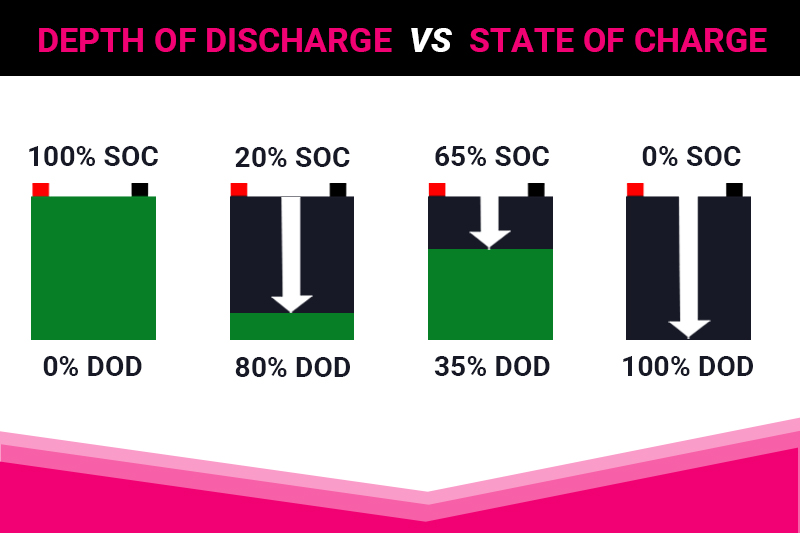
People often get perplexed between the depth of discharge and the state of charge while looking for a battery.
Although depth of discharge (DoD) and state of charge (SoC) are related, they are not the same!
DoD refers to the percentage of a battery’s capacity that has been used, while SoC indicates the remaining charge. Essentially, DoD represents how much energy has been drained, whereas SoC shows how much is left in the battery.
Depth of Discharge (DoD): A Game-Changer for Electric Vehicle Efficiency
While Australians are embracing electric vehicles as a sustainable solution to reduce their carbon footprint, DoD plays a significant role. It can enhance or worsen the battery life and overall driving experience.
For instance, frequent deep discharges can shorten the lifespan of EV batteries and chargers, reducing their range and efficiency over time.
In Australia, EV owners should keep the DoD of their vehicle batteries between 20% and 80% to ensure optimal performance. Many EV manufacturers recommend not letting the battery drop below 20%.
Keeping the DoD in this range will also help maintain the battery’s long-term health, which is crucial as replacing an EV battery in Australia can range from $5,000 to $20,000.
How to Manage Depth of Discharge in Electric Vehicles
- Use Regenerative Braking: Some modern electric vehicles have regenerative braking systems. These systems help to recharge the battery during braking, reducing battery strain.
- Avoid Full Discharge: Avoid letting your EV battery drain fully and leave it to 0%. To preserve its health, you can use a charge controller that handles safe charging automatically.
- Schedule your Charging Cycles: If you don’t need to drive long distances daily, consider only charging your EV to 80% rather than 100%. This ensures better battery performance.
Best Practices for Managing DoD in Solar Battery Storage Systems
- By staying within the recommended DoD range, you can maximize battery capacity and lifespan.
- Good battery health ultimately optimizes the home’s electric load offering more savings.
- Understanding DoD can help you plan when to draw energy from the battery, ensuring cost-effectiveness.
- Maximizing your battery’s capacity means you can be more self-sufficient and reduce dependence on grid electricity, offsetting grid power costs.
- A good solar battery promotes energy independence and sustainability.
- System calibration and monitoring tools let you track your battery’s state of charge, usage patterns, and DoD, increasing battery efficiency. This allows you to make adjustments in real-time.
Tips for Managing DoD in Solar Storage Systems
- Utilize a Battery Management System (BMS)
At present, most modern solar batteries are equipped with a BMS that monitors the state of charge (SoC) and helps ensure the DoD remains in the optimal range.
- Set Your Battery’s Charge Limit by Charge Controllers
Some battery systems allow you to set a maximum charge limit, preventing you from overcharging or discharging too deeply.
- Monitor Usage Patterns
Check your home’s energy usage patterns regularly. If your battery is consistently draining too deeply, it may be time to adjust your energy consumption habits or maximize battery capacity.
The Bottom Line: Why Australians Should Prioritize DoD for Better Battery Performance?
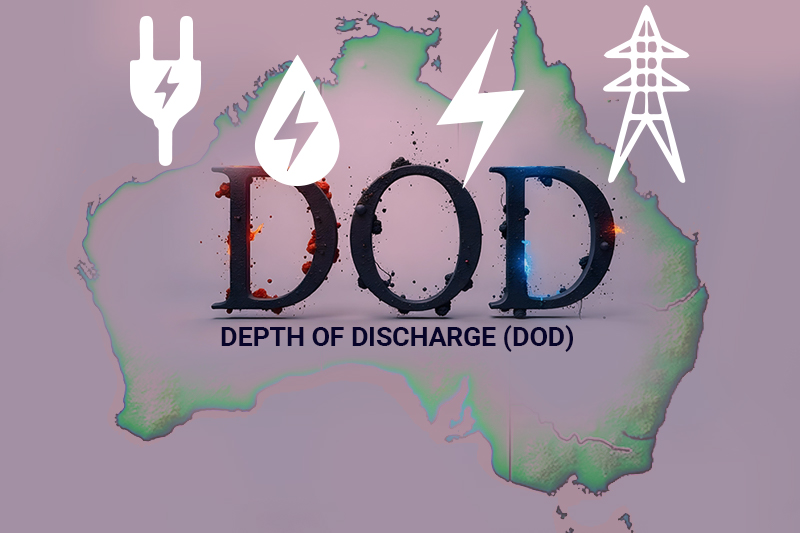
After reading all the ins and outs, you can now understand that why DoD matters for Australians.
Whether using solar storage systems, managing an electric vehicle, or looking to improve your energy independence, making informed decisions about DoD can significantly impact the performance and long-term value of your battery investment.
In Australia’s renewable energy-driven future, optimizing DoD will allow Australians to make the most of their solar energy systems, electric vehicles, and other energy storage solutions.
It ensures the residents and homeowners get the best value for their money while contributing to the country’s environmental goals.
Keep your eyes on Solar Emporium for more content like this! You can also contact us for any kind of solar products or information on renewable energy systems.
